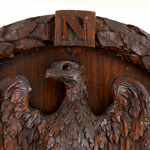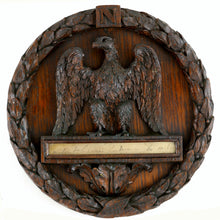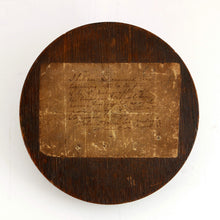Napoleon Bonaparte in Exile - The Emperor’s Autograph, Circa 1818
Adding product to your cart
Diameter: 13.7cm (5.4in)
An oak roundel carved with a Napoleonic eagle, its head to dexter, standing upon a glazed compartment containing Napoleon’s handwriting, the whole within a border of laurel leaves. The reverse applied with a contemporaneous paper label inscribed: ‘I believe the annotated line / beginning with ‘a la fin’ / to be the autograph of / the Emperor Napoleon / having perceived it as such from one of his suite at / Longwood in the year 1818 / John Stokoe late medical / attendant on Napoleon’
John Stokoe (1775-1852) was a Royal Navy surgeon and a veteran of Copenhagen and Trafalgar who served in Admiral Plamplin’s flagship Conqueror off St. Helena during Napoleon’s captivity. He attended Napoleon officially on 17 January 1819 and apparently attended him on five occasions before 21 January. However the Governor of St Helena Sir Hudson Lowe accused him of breaking the rules of contact with Napoleon and had him court-martialled and dismissed from the service.
Read more
In June 1817 Stokoe took the appointment in Conqueror with the expressed intention of meeting the man who, for so long had held all Europe in thrall - a chance he soon realised on a visit to see Napoleon’s appointed physician, Dr Edward O’Meara. Stokoe wrote ‘During the short time I was in the presence of Napoleon, my opinion underwent a complete change... I had not been two minutes in conversation with him before I felt myself as much at my ease as if talking to an equal.....accompanied with such a friendly feeling before him, that I could have been at that moment his ambassador to Sir Hudson”.
Sir Hudson Lowe, Governor of St. Helena, was considered to be ill-suited to the role of Napoleon’s gaoler, and was a man with a controlling and suspicious disposition who imagined traitors and plots at all sides. After a humiliating surrender of the garrison of Capri under his command during the Peninsula War, he was determined that no such expedition would be organised to deliver Napoleon his freedom. To this end he exerted his powers to increase Napoleon’s isolation and gave orders prohibiting all communications between the small French court at Longwood and the British subjects of the island.
O’Meara refused to spy for Lowe upon the General, as Napoleon was known in captivity, and soon found himself out of favour and dismissed from his post amid accusations of passing papers from Europe to the French. Stokoe, through his friendship with the fellow physician, also fell under suspicion, which was proved to be unfounded.
With the loss of O’Meara, General Bonaparte’s health rapidly declined, and as the only medical man the General would permit into Longwood, Stokoe begrudgingly accepted a position as his physician. Wary he would fall under the suspicion of Sir Hudson Lowe, Stokoe wrote full medical bulletins detailing his activities to be handed both to the Governor and to Napoleon’s staff at Longwood. These would later be used against him as proof of his passing prohibited documents to the French at his court-martial.
The final mistake came when Stokoe expressed his opinion in one of these bulletins that Napoleon’s health was adversely affected by the climate at St. Helena. This was a direct affront to Sir Hudson, who insisted (despite persistent rumors to the contrary) that Napoleon was fit and well, and could escape at any moment. Stokoe fell ill himself towards the end of 1818, and took leave to England, sailing on the Navy's newest frigate HMS Trincomalee, which had stopped at St. Helena on its maiden voyage in Janurary 1819. Whilst on leave in England Stokoe was recalled to St. Helena to face court-martial. Leaving no time to prepare his defense, and facing a court of Captains and Naval officers who relied on the Governor and his accomplice Admiral Plamplin for promotion, Stokoe was found unanimously guilty of communicating with the French against the Governor and Admiral’s express orders. The trail lasted for four days, from 30 August to 2 September 1819. Stokoe was dismissed from His Majesty’s service with only two months left before his retirement.
Sir Hudson Lowe remained deeply unpopular in England for his treatment of the old Emperor, and was later refused a pension of £1500, which had been readily given to his predecessor at St. Helena. On bringing this up with the Duke of Wellington, Lowe was met with a decidedly cold reception. The Duke told him bluntly that any referral to the House of Commons was quite useless - they would unanimously oppose such a grant.
Stokoe faired a little better. He was awarded a pension of £100 a year from the Civil List as well as £300 back pay, which was also enlarged with frequent gifts from Bonaparte’s surviving family. The Emperor, until his death, frequently called for Stokoe’s services, and in his delirium called his new physician by that familiar name.
Reference:
Fremeaux, P. & Stokoe, J. & E.S. (1902) ‘With Napoleon at St. Helena: being the memoirs of Dr. John Stokoe’, J. Lame, London and New York.
Unwin, B., (2010) ‘Terrible Exile, The Last Days of Napoleon St Helena’, Tauris, London & New York






